Biotechnology is entering a new era one where the fusion of life sciences and artificial intelligence (AI) is accelerating discovery, optimizing processes, and dramatically reducing time-to-market for novel solutions. From molecule design to clinical trial forecasting, AI is no longer a futuristic concept but a working tool reshaping the research and development (R&D) core of the biotech industry.
In this report, we break down the transformative role of AI across the biotech R&D pipeline, explore practical applications already in use, and highlight the opportunities this presents for forward-looking innovators and investors.
The Biotech-AI Convergence
Biotech R&D has traditionally been time-consuming and capital-intensive. It often involves billions in investment, years of clinical trials, and high failure rates. AI addresses these pain points through data-driven insights that enhance decision-making and automate complex workflows.
Key Drivers of AI Integration:
Explosion of biological data (genomics, proteomics, patient records)
Advances in machine learning and natural language processing (NLP)
Growing demand for cost-effective, faster research cycles
Cloud infrastructure enabling scalable computational biology
AI tools are being embedded at nearly every stage of biotech R&D—from early hypothesis generation to clinical development strategy—creating a new paradigm in life sciences innovation.
AI in Drug Discovery and Preclinical Research
The early phases of biotech development—identifying drug candidates and validating targets—have historically been labor-intensive and hypothesis-driven. AI is flipping this model by enabling:
1. Predictive Target Identification
AI algorithms scan vast datasets (such as genomics, transcriptomics, and literature) to find new biological targets. Deep learning models can infer complex interactions between genes, proteins, and diseases that may be invisible to human researchers.
2. Molecular Design and Simulation
AI-powered generative models can now design novel molecular structures with desired properties. Tools like AlphaFold, developed by DeepMind, have revolutionized protein folding prediction—cutting what once took years down to days.
AI-driven molecular docking simulations and QSAR models (Quantitative Structure-Activity Relationship) also allow researchers to predict how a compound might interact with its target, guiding medicinal chemistry decisions.
3. In Silico Testing
AI enables early virtual screening of thousands of compounds, reducing reliance on expensive and time-consuming wet-lab experiments. This step drastically lowers the number of physical experiments required, accelerating preclinical timelines.
AI in Biomarker Discovery and Personalized Research
AI excels in identifying patterns across large datasets. In biotech, this translates to the ability to detect biomarkers biological signals that predict disease, drug response, or prognosis.
Applications:
Patient stratification for clinical trials (matching therapies to the right subgroups)
Biomarker-based diagnostics that guide treatment decisions
Real-world data (RWD) mining for outcome prediction and unmet needs
Machine learning models are helping biotech companies move toward personalized research, where therapies can be developed with specific genetic or biological profiles in mind, enhancing both efficacy and safety outcomes.
AI in Clinical Trial Design and Optimization
Clinical trials are one of the costliest and most failure-prone stages of biotech development. AI helps mitigate risk and increase success rates through:
1. Site and Patient Selection
Natural language processing (NLP) and predictive modeling can analyze electronic health records (EHRs) to identify eligible patients and optimal trial sites based on historical recruitment success and population health patterns.
2. Trial Simulation and Forecasting
Digital twin technology—AI models that simulate real-world clinical scenarios—enables forecasting of trial performance before it begins. This helps refine protocols, adjust endpoints, and improve study designs.
3. Monitoring and Adaptive Design
AI-driven monitoring platforms provide real-time trial insights, flag anomalies, and enable adaptive design adjustments that make trials more flexible and efficient.
AI in Biomanufacturing and Process Optimization
As therapies move from development to production, biotech companies must ensure consistency, scalability, and compliance. AI contributes by:
Predictive maintenance of manufacturing equipment
Process control optimization using machine learning
Anomaly detection in real-time quality assurance data
Batch yield forecasting and material usage efficiency
AI-powered automation helps companies scale more quickly and avoid costly production errors, especially in personalized or small-batch biotech manufacturing.
Ethical Considerations and Regulatory Adaptation
As AI gains more decision-making power in biotech R&D, ethical and regulatory concerns grow. Key issues include:
Data privacy and consent when using patient-level health records
Algorithm transparency—black-box AI models can be difficult to interpret
Bias and fairness in training data, especially for personalized medicine
Regulatory oversight for AI-powered tools used in product development
Regulators in the U.S. and Europe are responding with frameworks to ensure that AI systems used in healthcare meet safety, efficacy, and accountability standards.
Example:
The EU AI Act, expected to come into force in stages starting 2025, classifies medical AI tools by risk and outlines transparency, testing, and documentation requirements.
The Investment Outlook: Why AI-Driven Biotech Is Gaining Traction
Investors are increasingly attracted to biotech firms that leverage AI to reduce risk and accelerate development. AI integration is viewed as a multiplier—one that can compress timelines, lower costs, and boost asset value.
Key signals investors watch for:
AI co-development partnerships with tech firms
In-house data science teams or proprietary platforms
Evidence of AI-driven efficiencies in pipeline progress
Regulatory approval pathways that factor in AI data
The most promising companies are those that embed AI not as an add-on, but as a core capability—integrated into R&D, regulatory planning, and commercial strategy.
Real-World Case Study (For Illustration Only)
A European biotech firm integrated machine learning models into its R&D platform, enabling it to reduce target identification timelines by 70% and preclinical screening costs by 50%. With adaptive trial design, it advanced two assets to Phase II within 18 months compared to the 3–5 years industry average.
This kind of performance is becoming increasingly common among AI-empowered innovators.
A Smarter, Faster Biotech Future
AI is no longer optional for biotech R&D—it’s foundational. Companies that embrace data-driven discovery, automation, and adaptive research models are not only accelerating time-to-market but also increasing their odds of long-term clinical and commercial success.
From de-risking investment portfolios to advancing personalized solutions, the integration of AI into biotech is one of the defining trends of this decade.



